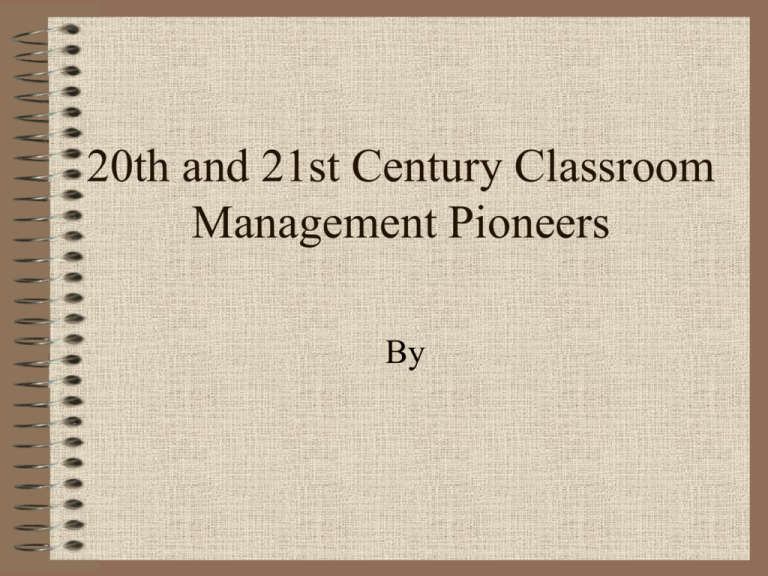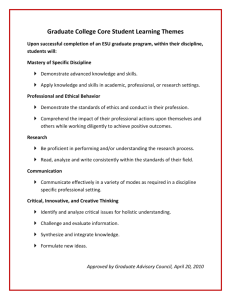20th and 21st Century Classroom Management Pioneers
advertisement

20th and 21st Century Classroom Management Pioneers By Discipline through Assertive Tactics Lee and Marlene Canter • Believed teachers should be in charge of their classrooms by being “calm, insistent and consistent” in their interaction with students • Developed the idea of student & teacher rights • Suggested that student behavior is tied to meeting student and teacher needs • These ideas were known as “Assertive Discipline” Discipline through Assertive Tactics continued • • • • • • Classified three types of teachers: ◦ Hostile: “view students as adversaries” ▪ takes away fun & trust ◦ Nonassertive: “overly passive” ▪ causes student insecurity & frustration ◦ Assertive: model & express clear expectations • ▪ meets student & teacher needs Discipline through Assertive Tactics continued • Encourages teachers to write out discipline plan that includes: • ◦ Rules: express how students should behave • ◦ Positive Recognition: rewards students who keep class expectations • ◦ Corrective Actions: must be consistent, shows students they've “chosen the consequences” • ◦ Discipline Hierarchy List: shares “corrective actions and the order in which they will be imposed within the day” • Suggest that students must be taught the discipline plan Discipline through Assertive Tactics Contributions to Discipline • Created the concept of rights in the classroom • Insisted teachers have a “right” to be supported by administration & parental support • Provided procedures for efficient correction of student misbehavior Discipline through Democratic Teaching Rudolf Dreikurs • Supposed that students behave best when they believe that good behavior has social value • Self control can be seen when students “show initiative, make reasonable decisions, and assume responsibility” • Suggests that teachers & students working together to decide how the class should work, creating a democratic classroom • ◦ Autocratic & Pessimistic classrooms don't have good discipline Discipline through Democratic Teaching continued • Believes students want to behave & belong, this is their “genuine goal” • ◦ Students feel they belong when the teacher & their peers provide “attention, respect, involve them in activities & don't mistreat them” • When students don't belong, they: • ◦ seek attention • ◦ seek power • ◦ seek revenge • ◦ feel inadequate Discipline through Democratic Teaching continued • When students misbehave, they're pursuing mistaken goals • ◦ teachers should correct students by identifying their behavior & discussing the faulty logic • Also suggested students & teachers create class rules together • ◦ Rules need logical consequences for following & breaking the rules • Believed punishment should never be used Discipline through Democratic Teaching Contributions • First to base discipline on social interest • First to suggest democratic structure of classroom management • Suggested teachers use encouragement • Made several suggestions for teachers about encouragement, a few: • ◦ “Always speak in positive terms” • ◦ Encourage students to seek improvement • ◦ Focus on student strength • ◦ Offer comments to encourage students • Teachers felt his system was difficult to “implement” & didn't stop immediate disruptions Discipline through Influencing Group Behavior Fritz Redl & Wattenberg • Believes students behave differently in a group then when they're alone • Felt group dynamics “strongly affect behavior” • Suggested students take on different “roles” in the classrooms • ◦ Class clown, leader, follower, etc. • Determined that students have roles teachers are expected to fill • ◦ role model, referee, judge, etc. Discipline through Influencing Group Behavior Continued • Determined that student behavior an be influenced by techniques like: • ◦ supporting student self control • ◦ offering situational assistance • ◦ appraising reality • Believes that punishment should be rarely used, never physical, and only consist of pre-planned consequences Discipline through Influencing Group Behavior Contributions • Identified group behavior as different from individual behavior ◦ Made it easier for teachers to understand confusing classroom behavior • Provided an organized discipline techniques that used humane strategies ◦ This helped develop and maintain positive student-teacher relationships • Stressed understanding why students don't behave ◦ Addressing causes for misbehavior will eliminate it Discipline through Influencing Group Behavior Contributions continued • Said students should be involved in making decisions about discipline ◦ This technique is now encouraged by most everyone • Showed the negative effects of punishment ◦ Explained why it should not be used in the classroom • These techniques were not used widely ◦ Difficult for teachers to understand, put into practice Ideas helpful, implementation difficult to do Discipline through Shaping Desired Behavior: B.F. Skinner • Believed that voluntary action is affected by immediate reinforcement • ◦ Rewards help motivate action • Reward= reinforcement stimulus • ◦ Must be given immediately after the good behavior • ◦ Can be results, awards, free-time, praise, etc. Discipline through Shaping Desired Behavior: Continued • Created techniques to use in shaping student behavior • ◦ Constant reinforcement: teacher provides every time student behaves well • ◦ Intermittent reinforcement: after students understand the classroom management system • The result of these techniques is success approximation: • ◦ When “behavior comes closer and closer to a preset goal” • Believed punishment should not be used because “its effects were unpredictable” Discipline through Shaping Desired Behavior: Contributions • His ideas led to “behavior modification” • ◦ Still used today for “strengthening and encouraging” learning • Not used as much in upper grades • ◦ Didn't tell students what “not to do” • ◦ Teachers ignored misbehavior • Lengthy process Improving Discipline through Lesson Management Jacob Kounin • Suggested teachers could manage a classroom well if they knew what was going everywhere in the classroom at all times • ◦ Teachers who know what's going on can anticipate problems and address them before they occur • Called teacher awareness “withitness” • ◦ Created “overlapping,” which means a teacher was involved with two or more classroom events at the same time Improving Discipline through Lesson Management Continued • Believed that lessons played a huge part in classroom management. • ◦ Group alerting: the whole class is paying attention before a teacher gives directions • ◦ Momentum: keeps students focused by making transitions, efficiency, etc. • ◦ Smoothness: also helps with management, as the teacher presents lessons and teaches them without changes. • Lesson should keep students from boredom and frustration Improving Discipline through Lesson Management Contributions • Connected teaching to student behavior & discipline • Not wholly adopted because didn't address how to deal with disruptive misbehavior Discipline through Congruent Communication Haim Ginott • Suggested that learning happened in real time • Encouraged teachers not to pre-judge students as learning is personal • ◦ Teachers should use “congruous communication,” which “stresses situations, not students' character or personality” • Teachers don't “preach, moralize, impose guilt or demand promises” • ◦ These are teachers at their best • ◦ Teachers at their worse “label... belittle... and denigrate” the characters of their students Discipline through Congruent Communication Continued • Teachers shouldn't dictate, but “invite cooperation” from students • ◦ Good teachers use the question “how can I be most helpful to my students right now?” • Good discipline involves using “I” instead of “You” messages • Suggested that “appreciate praise” is better than “evaluative praise” • ◦ Evaluative praise praises what “students have done, rather than referencing the student him or herself” Discipline through Congruent Communication Continued • Suggests teachers should respect student privacy • ◦ Teachers should be available, but not too curious • Suggests teachers avoid sarcasm & punishment • Determines that teachers should avoid behaving in ways that they don't want their students to behave • Believes classroom discipline is a process Discipline through Congruent Communication Contributions • “Showed the importance of the teacher being controlled” • Showed how valuable being on the same wavelength as the students is for teachers • It's easy to see these ideas in modern discipline systems • Some teachers feel the ideas don't stop misbehaviors quickly References Add the reference to the book here







